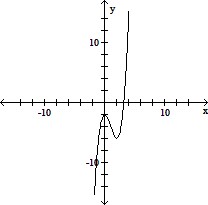Solve the equation.-  k = -
k = - 
A. k = -2
B. k = 0
C. k = 4
D. k = 1
Answer: C
You might also like to view...
Use the graph of the function f(x) to locate the local extrema and identify the intervals where the function is concave up and concave down.
A. Local minimum at x = 0; local maximum at x = 2; concave down on (0, ?); concave up on (-?, 0) B. Local minimum at x = 0; local maximum at x = 2; concave up on (0, ?); concave down on (-?, 0) C. Local minimum at x = 2; local maximum at x = 0; concave down on (0, ?); concave up on (-?, 0) D. Local minimum at x = 2; local maximum at x = 0; concave up on (0, ?); concave down on (-?, 0)
Change to decimal numbers.
A. 0.75 B. 0.8 C. 0.6 D. 0.075
Factor the four-term polynomial by grouping.4x + 40 + xy + 10y
A. (x + 10y)(4 + y) B. (x + 10)(4 + y) C. (y + 10)(x + 4) D. (y + 10)(4x + y)
Solve the problem.The time, in seconds, that it takes an object to fall a distance d, in feet, is given by the algebraic expression  . Find how long it will take a ball dropped from the top of a building
. Find how long it will take a ball dropped from the top of a building  tall to hit the ground. Write the answer in simplified radical form.
tall to hit the ground. Write the answer in simplified radical form.
A.  seconds
seconds
B.  seconds
seconds
C.  seconds
seconds
D.  seconds
seconds